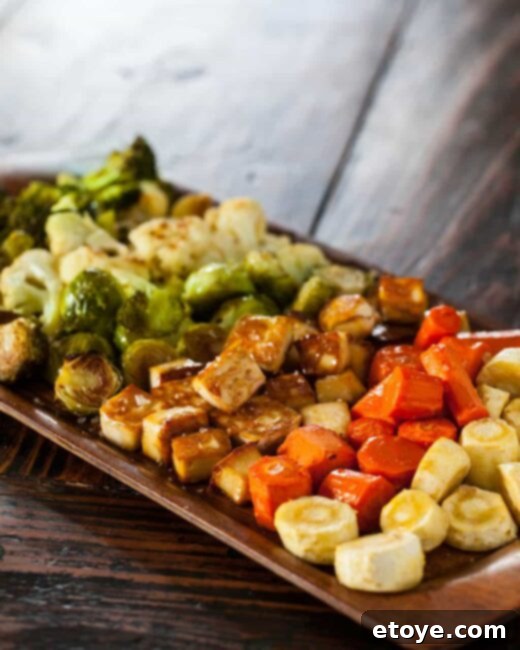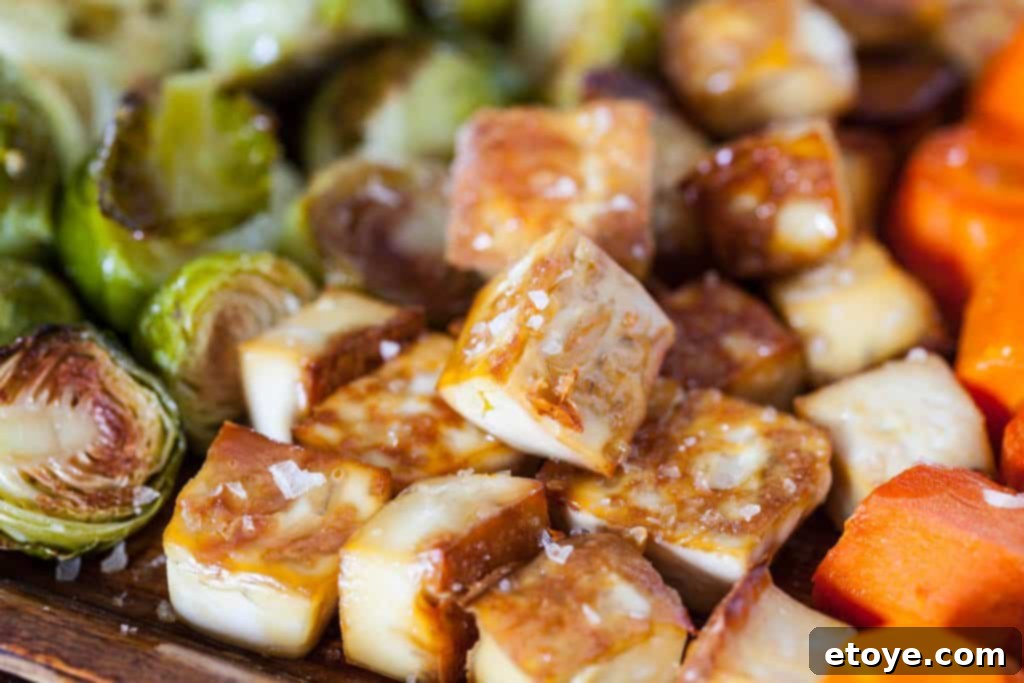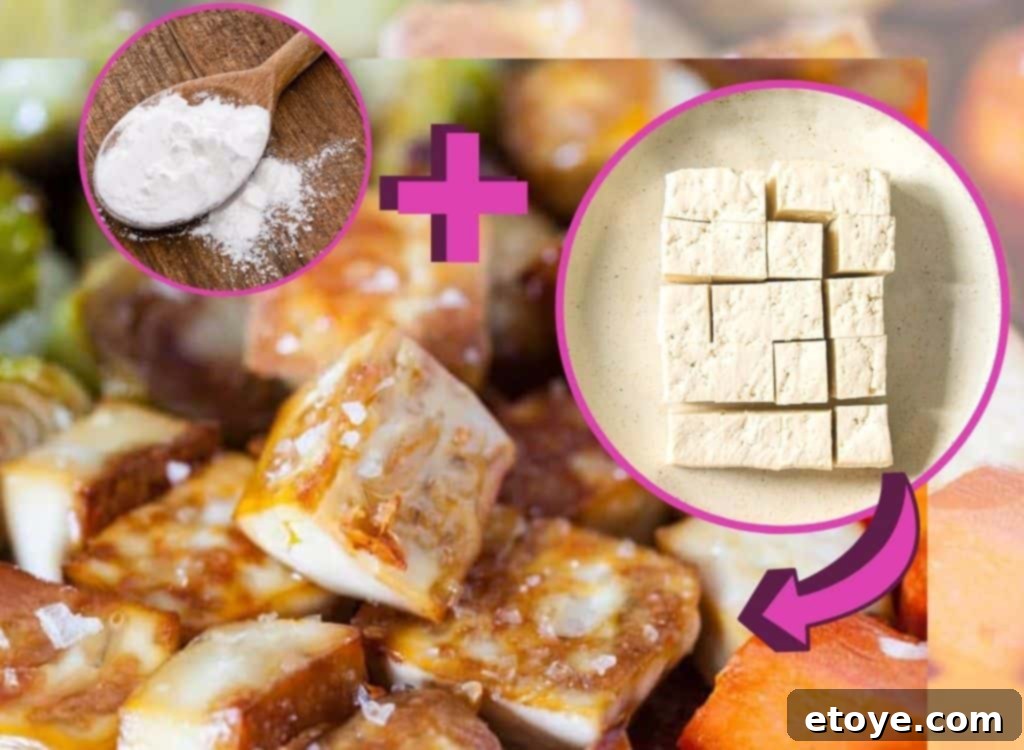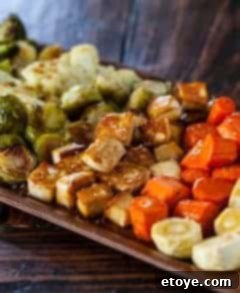Prepare a delightful array of roasted vegetables and perfectly crisp tofu all in one efficient oven session. The secret to this simplified cooking method lies in utilizing two sheet pans simultaneously – one for your golden tofu on the upper rack, and the other for your vibrant vegetables on the lower rack. Our ingenious shortcut to unlocking incredible flavor in your vegetables is a simple toss in your favorite store-bought salad dressing. Meanwhile, coating the tofu in a delicate layer of cornstarch guarantees an extra-crunchy crust that beautifully encases a light and creamy interior, creating a texture contrast that is simply irresistible.

Sheet Pan Roasted Tofu and Vegetables: Your Ultimate Guide to Crispy Perfection
Embark on a culinary journey to master the art of Sheet Pan Roasted Tofu and Vegetables, a recipe that stands as a testament to ease, flavor, and healthy eating. This comprehensive guide will equip you with the knowledge to consistently create a plant-based meal that’s not only incredibly delicious but also remarkably straightforward to prepare. Whether you’re a seasoned chef or a kitchen novice, our step-by-step instructions and expert tips will ensure your tofu achieves unparalleled crispiness and your vegetables are bursting with caramelized goodness, all with minimal fuss and cleanup.
Why Sheet Pan Roasting is a Game Changer for Busy Cooks
In today’s fast-paced world, finding meals that are both nutritious and quick to prepare can feel like a challenge. This is where sheet pan cooking shines, offering an unparalleled solution for busy individuals and families. The beauty of this method lies in its simplicity: combine your ingredients on a single (or in this case, two for optimal results) baking sheet, slide it into the oven, and let the magic happen. This hands-off approach frees you from constant stirring and monitoring, allowing you to multitask or simply relax while your dinner cooks.
Beyond convenience, sheet pan roasting promotes healthy eating. It requires minimal oil, and the high heat of the oven brings out the natural sweetness and depth of flavor in vegetables, often making them more appealing. The caramelization that occurs on the surfaces of both tofu and vegetables adds a layer of rich, savory taste that’s hard to achieve with other cooking methods. Furthermore, the limited use of cookware means significantly less cleanup post-meal, transforming dinner from a chore into a truly enjoyable experience. It’s an ideal choice for anyone looking to incorporate more plant-based meals into their diet without sacrificing flavor or time.

Mastering the Sheet Pan: Key Tips for Success
While sheet pan cooking is inherently simple, a few strategic tips can elevate your meal from good to absolutely outstanding. These insights will help you achieve perfectly cooked components every time, ensuring your roasted tofu is crispy and your vegetables are tender-crisp.
- **Optimize Oven Space with Two Pans:** The fundamental trick to achieving simultaneous perfection for both tofu and vegetables is to use two separate sheet pans. Place the tofu on a pan on the upper rack, where it receives more direct heat for maximum crispiness, and the vegetables on a separate pan on the lower rack. This prevents overcrowding, allows for even air circulation, and ensures each component roasts beautifully rather than steaming.
- **Embrace the Salad Dressing Shortcut:** Forget elaborate marinades! A high-quality store-bought salad dressing is your secret weapon for infusing your vegetables with an incredible burst of flavor effortlessly. Choose your favorite, whether it’s a zesty vinaigrette, a creamy ranch, or a tangy Italian dressing. For those who prefer a homemade touch, any of our Buddha Bowl sauces/dressings would also work wonderfully.
- **Parchment Paper for Seamless Cleanup:** To make post-dinner tidying an absolute breeze, always line your baking sheets with parchment paper. This non-stick barrier ensures that no food adheres to the pan, saving you scrubbing time and allowing you to enjoy your meal without the dread of dishes.
- **Customize with Your Favorite Vegetables:** This recipe is incredibly adaptable to whatever vegetables you have on hand or prefer. Our suggested combination includes nutrient-rich broccoli, cauliflower, carrots, parsnips, and Brussels sprouts. However, feel free to experiment with bell peppers, zucchini, sweet potatoes, or red onions. The key is to cut them into similar sizes for even cooking.
- **The Magic of Cornstarch for Tofu:** For tofu that boasts an irresistibly crispy, golden-brown exterior while maintaining a light and creamy interior, a light dusting of cornstarch is indispensable. This simple step creates a delicate crust that crisps up beautifully in the oven, transforming the texture of the tofu.

Achieving Unbeatable Crispy Tofu: The Ultimate Guide
Many home cooks struggle with achieving that coveted crispy texture when cooking tofu, often ending up with soft or chewy results. But with our straightforward, two-step method, you can consistently transform ordinary tofu into golden, crunchy bites that will satisfy even the most discerning palates. Say goodbye to soggy tofu and hello to a delightful crispy exterior with a tender, creamy interior, perfect for soaking up flavors and adding satisfying texture to any meal.

The Two Secrets to Extra Crunchy Tofu:
The secret to transforming soft tofu into a delightfully crunchy component lies in two crucial, yet simple, preparation steps:
**Step 1: Pressing the Tofu to Remove Excess Water**
Tofu, especially extra-firm varieties, contains a significant amount of water. This moisture is the primary culprit behind soggy, uninspiring tofu. Removing as much of this water as possible is the single most important step for achieving a truly crispy texture. When the water is pressed out, the tofu becomes denser and creates more surface area for crisping.
- **The Simple Home Method:** Lay a few layers of paper towels (or a clean kitchen towel) on a flat, sturdy surface like a cutting board. Place the block of drained extra-firm tofu on top. Cover the tofu with another few layers of paper towels. Then, place a second cutting board or a flat plate on top of the tofu. To apply pressure, stack several heavy items (such as cookbooks, cans of food, or even a cast-iron skillet) on the top cutting board. Let this setup sit for a minimum of 15-30 minutes. For truly superior crispiness, you can press it for up to an hour. You’ll be astonished by the amount of liquid released.
- **Using a Tofu Press:** For those who frequently cook with tofu, a dedicated tofu press is a highly recommended investment. These devices are designed to efficiently and consistently remove water from tofu, often much faster and with less mess than the manual method.
Once pressed, it’s vital to pat the tofu completely dry with fresh paper towels before moving to the next step. Any lingering surface moisture will hinder the crisping process.
**Step 2: The Cornstarch and Oil Coating for a Perfect Crust**
After your tofu is thoroughly pressed and dried, cut it into uniform 3/4-inch cubes. Uniformity is key here for even cooking. In a spacious bowl, gently toss the tofu cubes with about two tablespoons of olive oil. The oil helps to moisten the surface, allowing the cornstarch to adhere properly and also contributes to golden-brown edges during roasting.
Next, sprinkle one tablespoon of cornstarch (or arrowroot powder for a similar effect) and one teaspoon of garlic salt (or your preferred seasoning blend) over the oiled tofu. Toss gently again until every single tofu cube is lightly and evenly coated. The cornstarch forms a thin, virtually flavorless barrier that, when exposed to high oven heat, crisps up beautifully to create that coveted crunchy crust. It’s a game-changer for texture.
It’s important to note that for the tofu, we deliberately avoid tossing it in the salad dressing that the vegetables receive. We want the tofu to be as dry as possible, then coated simply with oil, cornstarch, and seasoning, to ensure it achieves that distinctively crispy exterior while the vegetables absorb the dressing’s vibrant flavors.
Maximizing Flavor and Minimizing Waste: Love Your Leftovers!
One of the many advantages of this sheet pan roasted tofu and vegetables recipe is how well it scales up. We purposely crafted the recipe to yield a generous batch, making it an absolute cornerstone for efficient meal preparation. Cooking a larger quantity means you’ll have delicious, healthy, and versatile ingredients ready to be transformed into quick meals throughout the week, significantly reducing your cooking time on busy days and cutting down on food waste.
Transforming Leftovers into Exciting Buddha Bowls
The leftover roasted tofu and vegetables are tailor-made for creating vibrant and satisfying Buddha Bowls. These customizable bowls are not only incredibly flavorful but also packed with nutrients. Simply reheat your leftovers (or enjoy them cold!), and combine them with a hearty grain base such as fluffy quinoa, wholesome brown rice, or a refreshing bed of fresh mixed greens. To elevate your Buddha Bowl further, consider adding extra toppings like creamy avocado slices, a sprinkle of toasted sesame seeds or chopped nuts for crunch, a handful of fresh herbs like cilantro or parsley, and a generous drizzle of your favorite sauce, such as a rich tahini dressing, a spicy peanut sauce, or a tangy vinaigrette. This transforms simple leftovers into a complete, balanced, and visually stunning meal.
But the versatility doesn’t stop at Buddha Bowls! Your delicious roasted leftovers can be creatively repurposed in numerous other ways:
- **Quick Wraps or Tacos:** Stuff the warmed tofu and veggies into soft tortillas or lettuce cups, adding a dollop of hummus, salsa, or a squeeze of lime for a quick, portable meal.
- **Hearty Salads:** Add them warm or cold to a base of fresh mixed greens, creating a substantial and protein-packed salad that’s perfect for lunch.
- **Stir-fry Enhancement:** Incorporate the roasted elements into a speedy stir-fry with noodles or rice, adding depth and texture without extensive extra cooking.
- **Flavorful Sandwiches:** Lightly mash the roasted tofu and mix it with some of the chopped vegetables, creating a unique and healthy sandwich filling.

Sheet Pan Roasted Vegetables and Tofu Recipe

This simple yet incredibly flavorful recipe delivers perfectly roasted tofu and vegetables, designed for maximum ease and amazing taste. Utilizing a store-bought salad dressing for a quick flavor boost and employing specific techniques for crispy tofu, this dish is a weeknight winner and a meal prep essential.
Author: Jaden Hair
Recipe Details
- Prep Time: 10 minutes
- Cook Time: 30 minutes
- Total Time: 50 minutes (includes tofu pressing time)
- Yields: 4 generous servings
- Course: Main Course, Side Dish
- Cuisine: American, Plant-Based
- Keywords: roasted tofu, tofu and vegetables, vegan tofu, vegetarian side, sheet pan meal, crispy tofu, easy dinner, healthy recipe
Equipment Needed
- 2 large baking sheets
- Parchment paper
- Large cutting board and heavy items for pressing tofu (or a tofu press)
- Large mixing bowls
Ingredients
For the Crispy Tofu:
- 1 pound extra firm tofu, thoroughly drained and pressed (see instructions)
- 2 tablespoons olive oil, plus extra for lightly greasing pans
- 1 tablespoon cornstarch
- 1 teaspoon garlic salt (or to taste, adjust with regular salt and garlic powder)
For the Flavorful Vegetables:
- 2 pounds mixed vegetables of your choice (e.g., broccoli florets, cauliflower florets, sliced carrots, parsnips, Brussels sprouts, bell peppers, onions)
- 3 tablespoons salad dressing of your choice (store-bought or homemade vinaigrette)
- Sea salt and freshly ground black pepper, to taste
Instructions
- **Prepare Oven and Pans:** Set your oven to cook with two racks for optimal heat distribution. Preheat your oven to 400°F (200°C). Line both large baking sheets with parchment paper for effortless cleanup. Lightly brush or drizzle a small amount of olive oil over the parchment paper on both pans.
- **Press the Tofu:** This is a crucial step for achieving crispy tofu. Lay 2-3 sheets of paper towel on your counter. Place the block of thoroughly drained extra-firm tofu on top. Cover with another 2 sheets of paper towel, then place a large cutting board on top. Weigh down the cutting board with several heavy items (e.g., heavy cookbooks, large cans, or a cast-iron skillet) to press out the moisture. Let it press for a minimum of 15 minutes, ideally 30 minutes, or even longer for the crispiest results.
- **Prepare Vegetables:** While the tofu is pressing, wash and prepare your chosen vegetables. Cut denser vegetables (like carrots, parsnips, or potatoes) into approximately 3/4-inch cubes or uniform pieces. Cut medium-density vegetables (like cauliflower or Brussels sprouts) slightly larger than the dense ones. Broccoli florets can be cut slightly larger than cauliflower. Thin vegetables (such as onion wedges or bell pepper strips) should also be cut into appropriate sizes to ensure even cooking and similar roasting times. In a large mixing bowl, toss the cut vegetables thoroughly with your preferred salad dressing until all pieces are evenly coated. Spread the dressed vegetables in a single layer on one of the prepared baking sheets.
- **Prepare the Tofu:** Once the tofu has been pressed, pat it completely dry with fresh paper towels. Cut the tofu block into uniform 3/4-inch cubes. In a separate large bowl, gently toss the tofu cubes with 2 tablespoons of olive oil until lightly coated. Then, sprinkle in the cornstarch and garlic salt, tossing again until every tofu cube is lightly and evenly coated with the dry ingredients.
- **Initial Tofu Roasting:** Arrange the seasoned tofu cubes in a single layer on the second prepared baking sheet, ensuring they are not touching for maximum crispiness. Place this baking sheet on the upper rack of your preheated oven. Set a timer for 30 minutes.
- **Add Vegetables to Oven:** After the tofu has been roasting for approximately 10 minutes, place the baking sheet with the prepared vegetables on the lower rack of the oven. This allows the tofu to get a head start on crisping while the vegetables begin to soften.
- **Continue Roasting and Flipping:** Allow both the tofu and vegetables to cook for an additional 20 minutes. At this 20-minute mark (or 30 minutes total for tofu), carefully remove both sheets from the oven. Using a spatula, flip the tofu cubes to ensure even browning and crispiness on all sides. Stir the vegetables as well to promote even caramelization. Return both baking sheets to the oven. Continue cooking the tofu for another 5-10 minutes, or until it has reached your desired level of golden-brown color and crispiness. The vegetables should be tender-crisp and slightly caramelized. Keep in mind that the tofu will continue to firm up and crisp slightly as it cools.
- **Season and Serve:** Carefully remove both baking sheets from the oven. Season everything with additional sea salt and freshly ground black pepper to taste. Serve hot, either on its own as a hearty side dish or a light main, or over a bed of fluffy rice, nutritious quinoa, or fresh mixed greens for a complete and satisfying meal. Enjoy your perfectly crispy tofu and flavorful roasted vegetables!
Nutrition Information (per serving)
- Calories: 302 kcal
- Carbohydrates: 36g
- Protein: 16g
- Fat: 13g
- Saturated Fat: 2g
- Sodium: 864mg
- Potassium: 664mg
- Fiber: 9g
- Sugar: 2g
- Vitamin A: 11517 IU
- Vitamin C: 24mg
- Calcium: 92mg
- Iron: 4mg
(Nutritional values are approximate and may vary based on specific ingredients, portion sizes, and brands used.)
Tried this easy and delicious recipe? We’d love to hear about your experience! Share your feedback and how it turned out in the comments section below. Your insights and tips are invaluable to our cooking community!
Why This Recipe is a Must-Try: Health Benefits and Simplicity
Beyond its undeniable convenience and delightful taste, this Sheet Pan Roasted Tofu and Vegetables recipe is a powerhouse of nutrition, making it an excellent choice for a healthy lifestyle. Tofu, the star of this plant-based dish, is a complete protein source, providing all nine essential amino acids necessary for human health. It’s also rich in iron, calcium, manganese, selenium, and phosphorus, contributing to bone health, energy production, and overall well-being. Its low saturated fat content and cholesterol-free nature make it a heart-healthy alternative to animal proteins.
When paired with a colorful assortment of roasted vegetables, this meal becomes a vibrant tapestry of vitamins, minerals, antioxidants, and dietary fiber. Vegetables like broccoli, cauliflower, and Brussels sprouts are cruciferous powerhouses known for their potential anti-cancer properties and high fiber content, which promotes digestive health and helps regulate blood sugar levels. Carrots and parsnips add a touch of natural sweetness and are excellent sources of Vitamin A. Roasting these vegetables not only enhances their inherent flavors through caramelization but also makes it easier to consume a wider variety of nutrients in one delicious sitting.
This recipe is inherently accommodating to various dietary needs, being naturally vegan, vegetarian, and gluten-free (just ensure your chosen salad dressing is certified gluten-free). It exemplifies how straightforward, whole-food ingredients, combined with smart and efficient cooking methods, can result in meals that are both incredibly satisfying and profoundly beneficial for your health. It’s a testament to the idea that healthy eating doesn’t have to be complicated or time-consuming.
Customization and Variations: Make It Your Own!
One of the most appealing aspects of sheet pan meals, and particularly this recipe, is its incredible flexibility. It serves as a fantastic foundation, inviting you to unleash your culinary creativity and tailor the dish to your specific preferences, dietary needs, or whatever ingredients you happen to have in your pantry. Don’t be afraid to experiment and make this recipe truly your own!
- **Explore Different Vegetable Combinations:** While our suggested mix is a crowd-pleaser, the possibilities are endless. Consider adding or substituting with:
- **Hearty Root Vegetables:** Sweet potatoes, red potatoes, butternut squash, or even beets (cut into smaller pieces).
- **Colorful Fruiting Vegetables:** Sliced bell peppers (of various colors), zucchini, yellow squash, cherry tomatoes (add these halfway through cooking to prevent sogginess).
- **Greens:** Toss in some kale or spinach during the last 10 minutes of roasting for a tender wilt.
- **Aromatics:** Red onion wedges, shallots, or leeks add another layer of savory flavor.
- **Elevate Tofu Flavor with Marinades:** Before the cornstarch coating, you can infuse your pressed tofu with extra flavor. Marinate it for 15-30 minutes in a mixture of soy sauce (or tamari for gluten-free), grated ginger, minced garlic, and a touch of sesame oil for an Asian-inspired profile. Alternatively, try a blend of nutritional yeast, smoked paprika, and a dash of liquid smoke for a “cheesy” or “bacony” flavor. Always pat the tofu dry again after marinating and before tossing with cornstarch.
- **Adventure with Salad Dressings:** The choice of salad dressing can dramatically alter the flavor profile of your entire dish. Get adventurous!
- **Asian Fusion:** Try a sesame ginger, peanut, or sweet chili dressing.
- **Mediterranean Vibes:** Opt for a lemon herb vinaigrette, a bright balsamic glaze, or a creamy Greek dressing.
- **Spicy Kick:** A Sriracha-lime dressing, a chili-garlic sauce, or a spicy tahini dressing can add a fiery punch.
- **Creamy Indulgence:** A vegan ranch or a rich creamy Italian dressing can provide a comforting, familiar taste.
- **Boost with Herbs and Spices:** Sprinkle your vegetables with additional spices like smoked paprika, ground cumin, Italian seasoning, or a pinch of cayenne pepper for extra warmth and complexity. Fresh herbs such as rosemary, thyme, or oregano can be added to the vegetables before roasting, or a scattering of fresh cilantro or parsley as a vibrant garnish after cooking.
- **Alternative Plant-Based Proteins:** While tofu is fantastic, the sheet pan method works beautifully with other plant-based proteins too. Consider using firm tempeh (cubed and marinated), canned chickpeas (drained, rinsed, and tossed with spices), or pre-cooked vegan sausages (sliced).
By exploring these customization options, you can ensure that your sheet pan roasted tofu and vegetables meal remains fresh, exciting, and perfectly suited to your evolving tastes and preferences, making it a staple in your meal rotation.
